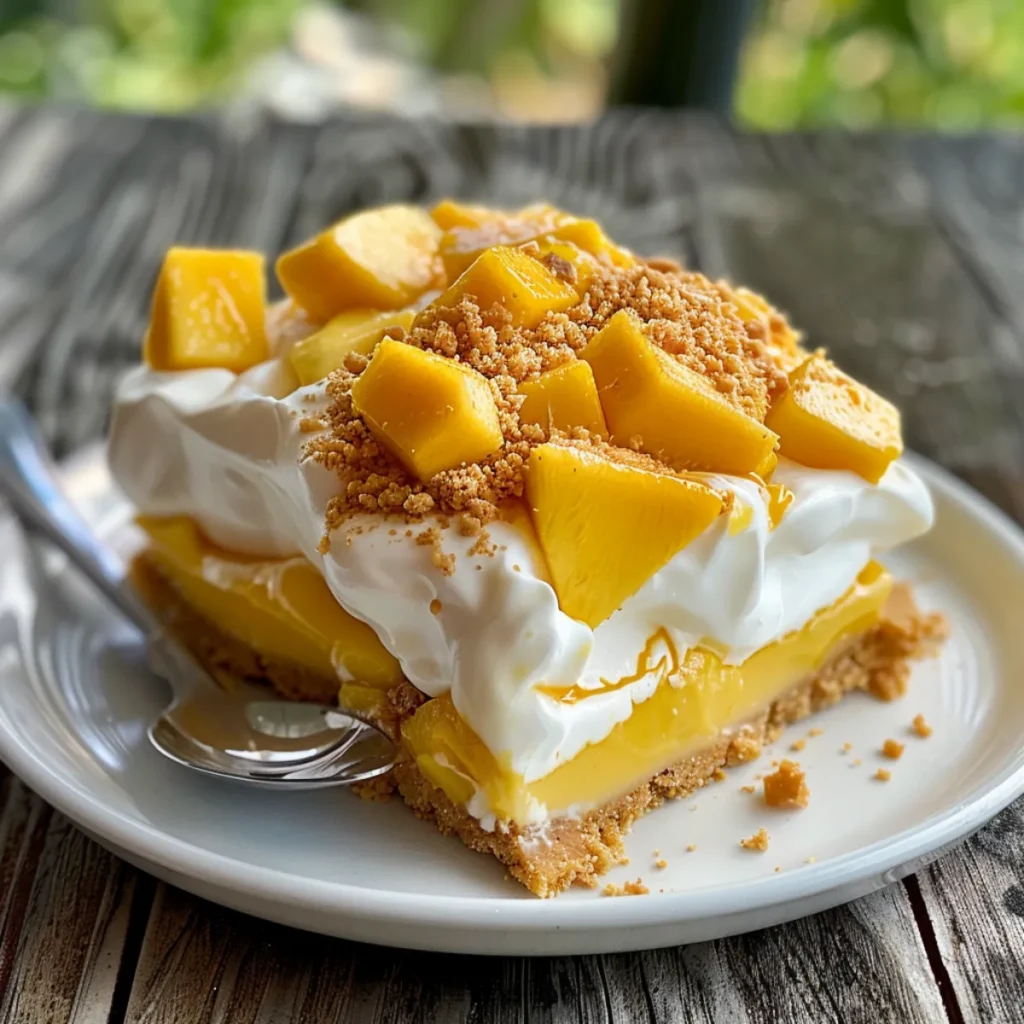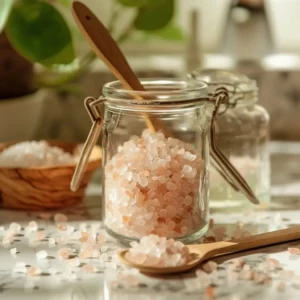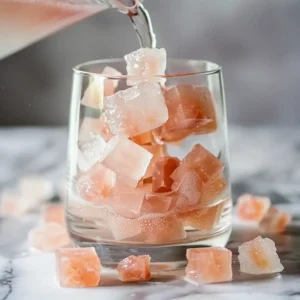Introduction
Mango float is one of those desserts that sneaks up on your heart. The first time I had it, I was visiting a friend’s family in Manila, and someone pulled out a chilled tray of what looked like golden sunshine trapped between clouds. One spoonful later, I was hooked. This no-bake Filipino treat layers juicy mangoes, fluffy whipped cream, and honeyed graham crackers in a cool, creamy stack that melts on your tongue.
In this guide, I’m taking you through everything I’ve learned (and fumbled) about mango float over the years. We’ll explore where it came from, how to make it perfectly every time, the best ingredients, and even fun variations like single-serve cups or diet-friendly tweaks. And because I’ve made my fair share of kitchen flops, I’ll also share tips to avoid the most common mistakes.
Table of Contents
Table of Contents
What Is Mango Float and Why It’s So Popular
Origins of Mango Float in Filipino Cuisine
Mango float, also known as crema de mangga in some Filipino households, is a chilled dessert that became a staple during the 1990s. It borrows inspiration from the classic icebox cakes of the U.S., but Filipinos gave it a tropical twist by incorporating their favorite fruit—mangoes. No baking, no cooking—just assembling layers and letting the fridge do its magic.
As someone who loves tracing food stories, what stands out to me is how mango float became a dessert for every class and kitchen. Whether at a birthday, a fiesta, or just a weekend treat, it shows up ready to win hearts. It’s the kind of recipe that’s passed down through generations and reinvented with every household’s touch.
What Makes Mango Float a Beloved Dessert
There’s something emotionally comforting about mango float. The sweetness of ripe mangoes paired with the creamy texture of whipped cream gives it an almost nostalgic quality. Plus, it’s so easy to make—no fancy tools, no oven, and barely any cleanup.
Let me tell you, this dessert shines in its simplicity. A slice brings back summer memories, shared laughs around the table, and the clink of chilled dessert plates. It’s no wonder that mango float is often the first dessert a young Filipino learns to make. And once you’ve had it? Well, you’ll probably keep a tub of it in your freezer like I do.
Key Ingredients for the Best Mango Float
Choosing the Right Mangoes (Fresh vs. Canned)
If you ask me, the soul of mango float lies in the mangoes. Get that right, and you’re halfway to dessert heaven.
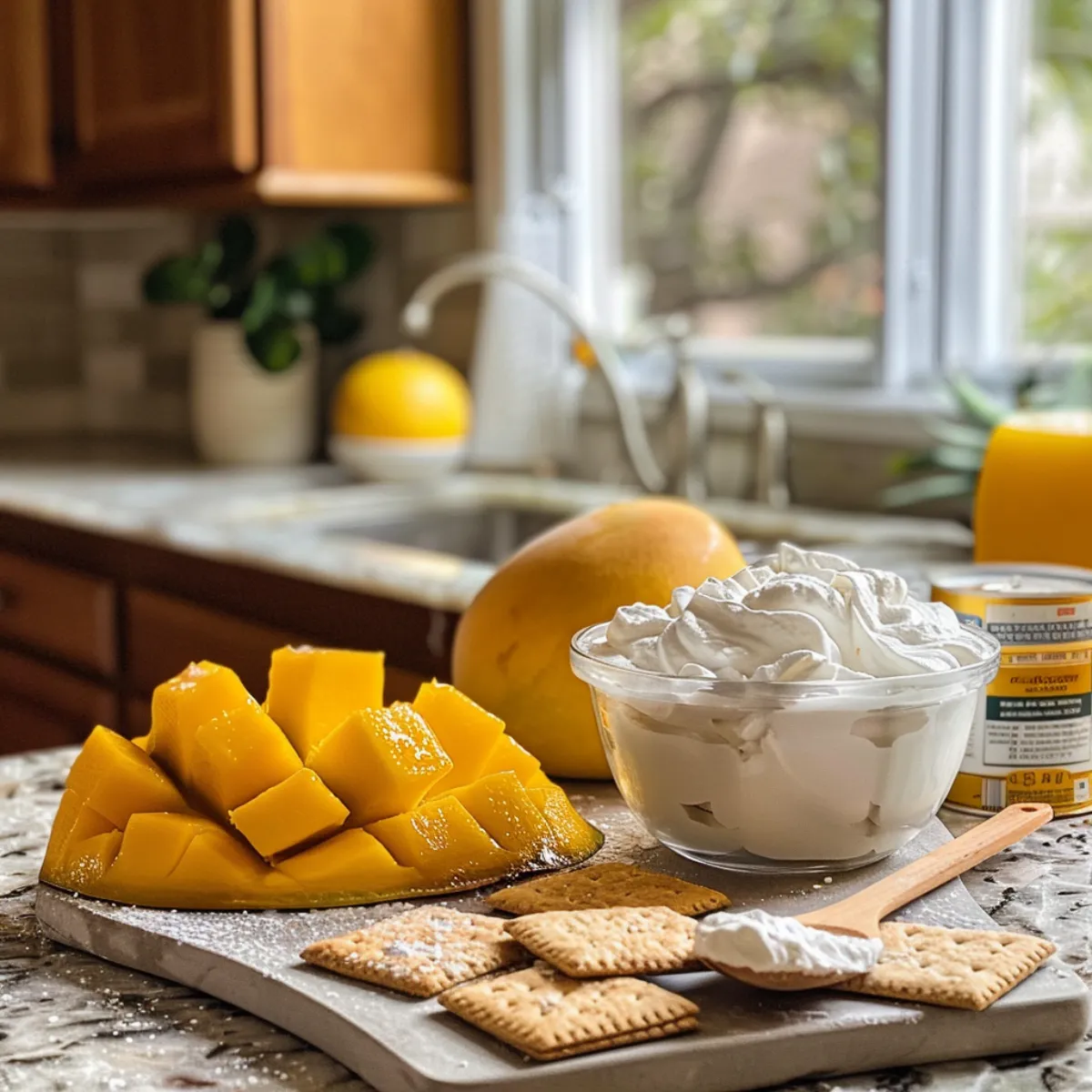
Fresh mangoes are the gold standard—especially if you can get your hands on Philippine Carabao mangoes. They’re lusciously sweet, non-fibrous, and practically melt in your mouth. When I lived in Cebu for a short while, I’d buy them by the dozen, just to eat one and save the rest for float.
But I know fresh mangoes aren’t always available year-round or in every store. So, can you use canned mango? Absolutely—but with a little caution.
Here’s what I’ve learned:
| Mango Type | Pros | Cons |
|---|---|---|
| Fresh Mangoes | Sweet, vibrant, best flavor | Seasonal, must be ripe |
| Canned Mangoes | Convenient, shelf-stable | Often packed in syrup, softer texture |
| Frozen Mangoes | Available year-round | May need to be thawed & drained |
If using canned, make sure to drain them well, and pat dry with paper towels if needed. Too much liquid can make your layers soggy. Taste and adjust the sweetness of your cream base accordingly, since syrupy mangoes can tip the balance.
All About Graham Crackers and Cream Mixtures
Let’s talk layers—because the graham and cream combo is what gives mango float its signature texture.
Graham crackers act as the structural base. They absorb moisture and soften over time, turning cake-like without a single minute in the oven. Some folks like to crush them into crumbs; I prefer layering them whole for that neat, square-slice presentation.
As for the cream mixture, I’ve tested everything from all-purpose cream to homemade whipped cream and even cream cheese blends. Here’s what I found:
- All-Purpose Cream + Condensed Milk: The classic combo—rich, sweet, and super easy to whip together.
- Whipped Cream + Cream Cheese: Adds a tangy balance to the mango’s sweetness, perfect for a more mature palate.
- Coconut Cream Alternative: Ideal if you’re going dairy-free, and it adds a tropical aroma that pairs well with mango.
Pro Tip: Chill your cream before whipping to make it fluffier. If it’s too warm, you’ll end up with a runny mess—and I’ve learned that the hard way!
Step-by-Step Guide to Making Mango Float
Basic Mango Float Recipe with Tips
The beauty of mango float is how unfussy it is. You don’t need a fancy mixer or hours in the kitchen—just a few good ingredients, a bit of layering love, and some fridge time.
Here’s my go-to basic mango float recipe that never fails:
Ingredients:
- 3 ripe mangoes (or 2 cups canned mangoes, drained and dried)
- 2 cups all-purpose cream (chilled)
- ¾ cup condensed milk (adjust to taste)
- 1 pack of whole graham crackers
- Optional: crushed graham for topping
Instructions:
- Prepare the mangoes: Slice into thin strips or cubes. I prefer strips—they make layering neater.
- Whip the cream: Beat chilled all-purpose cream until slightly thick, then fold in condensed milk. Taste-test the sweetness!
- Layer it up: Start with a thin layer of cream at the bottom of your dish. Add a layer of graham crackers, followed by cream, then mango slices.
- Repeat the layers: Do this until you run out of ingredients, finishing with a thick cream layer topped with mango and a sprinkle of crushed graham.
- Chill: Cover and refrigerate for at least 6 hours—overnight is even better. The graham crackers need time to absorb moisture and soften.
Sifaw’s Shortcut: If you’re short on time, freeze the float for an hour, then chill it in the fridge for another two. It speeds up the softening while keeping things creamy.
Layering Techniques for Maximum Flavor
Want your mango float to look like it came straight out of a dessert café? It’s all in the layering.
Here are some tricks I’ve learned through trial (and, yes, a few oozy, messy errors):
- Even Spreads: Use an offset spatula or the back of a spoon to spread the cream layer evenly. Avoid thick blobs—they’ll smother the crackers.
- Full Coverage: Make sure mango slices cover every edge. This way, every bite gets that sweet, fruity punch.
- Corner Press: Gently press the crackers into place, especially at the corners. This keeps the float firm when slicing later.
If you’re feeling playful, try building individual mango float cups using mason jars or dessert glasses. They’re cute, portable, and perfect for picnics or gifting. Plus, kids love them!
Variations of Mango Float to Try at Home
Mango Float in a Cup or Jar
There’s something charming about single-serve desserts. If you’re hosting a party or packing treats for a picnic, mango float cups or jars are a game-changer.
Here’s how I make them when I want to impress without the stress:
- Use clear plastic cups or mason jars to showcase those luscious layers.
- Slice your mangoes into small cubes instead of strips for better scoopability.
- Crumble your graham crackers between layers instead of placing them whole. This helps fit everything neatly in a small container.
Not only do these individual servings look beautiful, but they’re also easier to serve and carry. Guests won’t even need a knife—just a spoon and a smile.
Mango Graham Cake vs. Classic Float
Is mango graham cake the same as mango float? Well, almost—but not quite. In many Filipino households, the terms are used interchangeably, but here’s the subtle difference I’ve discovered:
| Feature | Mango Float | Mango Graham Cake |
|---|---|---|
| Shape | Usually rectangular dish | Often in layered round pans |
| Mango Style | Sliced or layered | Cubed or puréed |
| Presentation | Rustic, homestyle | More polished, cake-like |
| Texture | Creamy and chilled | Can be semi-frozen or firmer |
Some folks even freeze their graham cake slightly to create cleaner layers and a firmer bite, which makes it resemble an ice cream cake. I’ve tried this during summer gatherings, and the kids loved it. Just make sure to let it thaw for a few minutes before serving so it’s not rock solid.
If you love fusion desserts like I do, try blending techniques—use crushed graham for one layer, keep others whole, or fold a bit of cream cheese into your whipped topping. The possibilities are endless!
Tips and Tricks to Get It Perfect Every Time
How to Keep Your Layers Neat and Creamy
One thing I’ve learned after making mango float more times than I can count? Neat layers matter. Not just for aesthetics—but for the balance of flavor and texture in every bite.
Here’s how I make mine picture-perfect:
- Start with a chilled cream base. Cold cream thickens faster and gives you that luxurious, fluffy texture. Warm cream = soupy disaster.
- Slice mangoes thinly and evenly. Uneven chunks can make your layers look bumpy and awkward.
- Use a flat spatula or the back of a spoon. Gently spread your cream evenly to avoid pulling up the graham crackers underneath.
- Alternate directions of mango slices with each layer for better stability and appearance.
And remember, mango float isn’t a race. Take your time with each layer—it’s a kind of edible art.
Optional Bonus: Dust the top with crushed graham crackers and drizzle a bit of mango purée for a bakery-worthy finish. It’s a small touch that brings a big “wow.”
Chilling Time and Storage Best Practices
If there’s one thing you shouldn’t rush, it’s chill time. The longer your mango float rests in the fridge, the better the graham layers soak up that cream and mango flavor. That’s where the magic happens.
Here’s what I recommend for optimal results:
| Chill Time | Texture Outcome |
|---|---|
| 3–4 hours | Still a bit firm, uneven layers |
| 6 hours | Good, but slightly soft |
| Overnight (8–12) | Perfectly set and sliceable |
Storage Tips:
- Use an airtight container or cover the tray tightly with foil or cling wrap.
- Keeps fresh for 3–4 days in the fridge.
- Can be frozen for up to 2 weeks, but defrost slightly before serving.
One time, I accidentally left mine uncovered overnight and it absorbed the smell of the leftover garlic pasta sitting nearby—yeah, not great. Since then, I never skip the cling wrap.
For a firmer texture (especially in warmer climates), pop it in the freezer for the first hour after assembling, then let it finish chilling in the fridge.
Common Mistakes to Avoid
Using Too Much Liquid or Unripe Mangoes
One of the easiest ways to mess up a mango float is by overloading the cream—or using mangoes that aren’t ripe enough. I’ve learned this the hard way during a summer brunch with friends when my mango float turned out runny and oddly tart.
Here’s what to watch for:
- Too much cream mixture: It might seem like a good idea to make it extra creamy, but overdoing it will lead to a soggy base. You want just enough to coat the layers—don’t drown them.
- Unripe mangoes: These are firm, sour, and lack that tropical punch of sweetness. They also don’t soften much in the fridge. Use mangoes that give slightly to the touch and have a strong fruity aroma.
If you only have canned or frozen mangoes, remember:
- Drain them completely
- Pat them dry with a paper towel
- Taste before layering
Using quality mangoes is non-negotiable for that iconic flavor. The mango is the star—don’t give it a bad script.
Skipping Chill Time or Poor Layering
I get it—you’re eager to dig in. But mango float isn’t a dessert you can rush. Skipping chill time or getting sloppy with layers ruins the final result.
Here are a few layering errors I’ve made—and learned from:
| Mistake | Problem | Solution |
|---|---|---|
| Adding too much cream early | Base becomes soggy | Use thin layers, especially at the bottom |
| Uneven cracker placement | Wobbly texture when slicing | Align graham crackers edge to edge |
| No chill time | Runny, soupy mess | Chill at least 6 hours, overnight is best |
I once served a mango float after only two hours in the fridge and ended up with something that looked (and felt) like pudding soup. Never again.
Bonus Tip: For cleaner cuts, use a hot knife (dip in warm water and wipe dry) before slicing.
Mango Float for Every Occasion
Making Ahead for Parties and Potlucks
One of the things I love most about mango float is how party-friendly it is. It’s a prep-ahead dessert that only gets better with time, which means no last-minute scrambling when guests arrive.
Here’s how I do it for gatherings:
- Make it the night before. This gives the graham crackers time to absorb the cream and mango juices.
- Use disposable trays if you’re bringing it to a potluck—it travels well and saves cleanup.
- Top it just before serving. Add fresh mangoes, crushed graham, or even mint leaves for a pop of color and freshness.
If I’m making a big batch, I double the recipe and use a deep glass dish for a “taller” float. It’s always a showstopper when sliced.
Adapting for Kids or Diet-Friendly Options
Now, let’s talk healthy(ish) tweaks. I’ve had friends on low-sugar diets, and little ones who can’t do full-fat cream, so I’ve tested a few alternatives:
For Kids:
- Use mini cups or muffin tins to create kid-sized portions.
- Swap in graham cereal or soft vanilla wafers if they prefer less crunch.
- Add fruit jelly cubes or sprinkles on top to make it extra fun.
For Healthier Versions:
- Use light cream or Greek yogurt instead of full cream.
- Reduce condensed milk and add a touch of honey or mashed ripe banana for sweetness.
- Try sugar-free graham crackers and skip added toppings like crushed cookies.
| Swap This | For This | Why It Works |
|---|---|---|
| Condensed milk | Coconut milk + honey | Keeps it creamy with less sugar |
| Graham crackers | Gluten-free biscuits | For GF-friendly diets |
| Heavy cream | Whipped Greek yogurt | Protein boost, less fat |
One summer, I served a “healthier” mango float at a beach picnic using whipped coconut cream and gluten-free grahams—nobody even noticed it was a lighter version. It still had all the creamy, mango-rich goodness we love.
Mango Float vs. Similar Desserts
Comparing Mango Float to Mango Graham Cake
To be honest, I used to think mango float and mango graham cake were the exact same thing. It wasn’t until I tried both at a Filipino birthday party that I realized the subtle yet meaningful differences.
Here’s how they stack up:
| Feature | Mango Float | Mango Graham Cake |
|---|---|---|
| Texture | Soft, creamy, melt-in-your-mouth | Slightly firmer, more cake-like |
| Mango Use | Sliced or thinly layered | Often chopped or puréed |
| Presentation | Served in trays, rustic look | May be molded in cake pans, neater finish |
| Serving Temperature | Best chilled | Can be chilled or partially frozen |
| Layers | Freestyle layering | Structured, like a layer cake |
Mango float is the more casual cousin—rustic, no-fuss, and all about that nostalgic comfort. Meanwhile, mango graham cake is what you’d serve when you want the same flavors but in a more polished format.
Some even call mango graham cake the “birthday party version” of mango float!
Difference from Mango Royale and Mango Refrigerator Cake
Now let’s talk about mango royale and mango refrigerator cake—two names that float around the Filipino dessert scene.
Let me break it down from my own kitchen experiments:
- Mango Royale: A fancier take on mango float. Often uses cream cheese or mascarpone, and may include additional elements like almond crusts or gelatin layers. It’s more of a showpiece dessert.
- Mango Refrigerator Cake: This is a broad term in the Philippines that refers to any chilled cake. Mango float is technically a type of refrigerator cake—but not all fridge cakes are mango float!
Think of it this way:
- Mango Float = Specific dessert with graham, cream, mango
- Mango Refrigerator Cake = General category of no-bake, chilled cakes
- Mango Graham Cake = Slightly more structured version of mango float
- Mango Royale = Fancy mango float with extra ingredients
No matter which version you go for, the common denominator is always that bright, sweet mango flavor we all crave.
Pairing and Serving Suggestions
Best Drinks to Serve with Mango Float
Mango float may be creamy and rich, but when paired with the right drink, it becomes next-level good. Whether you’re enjoying it at a summer cookout, a potluck, or a quiet Sunday afternoon, these beverages complement the flavors without overpowering them.
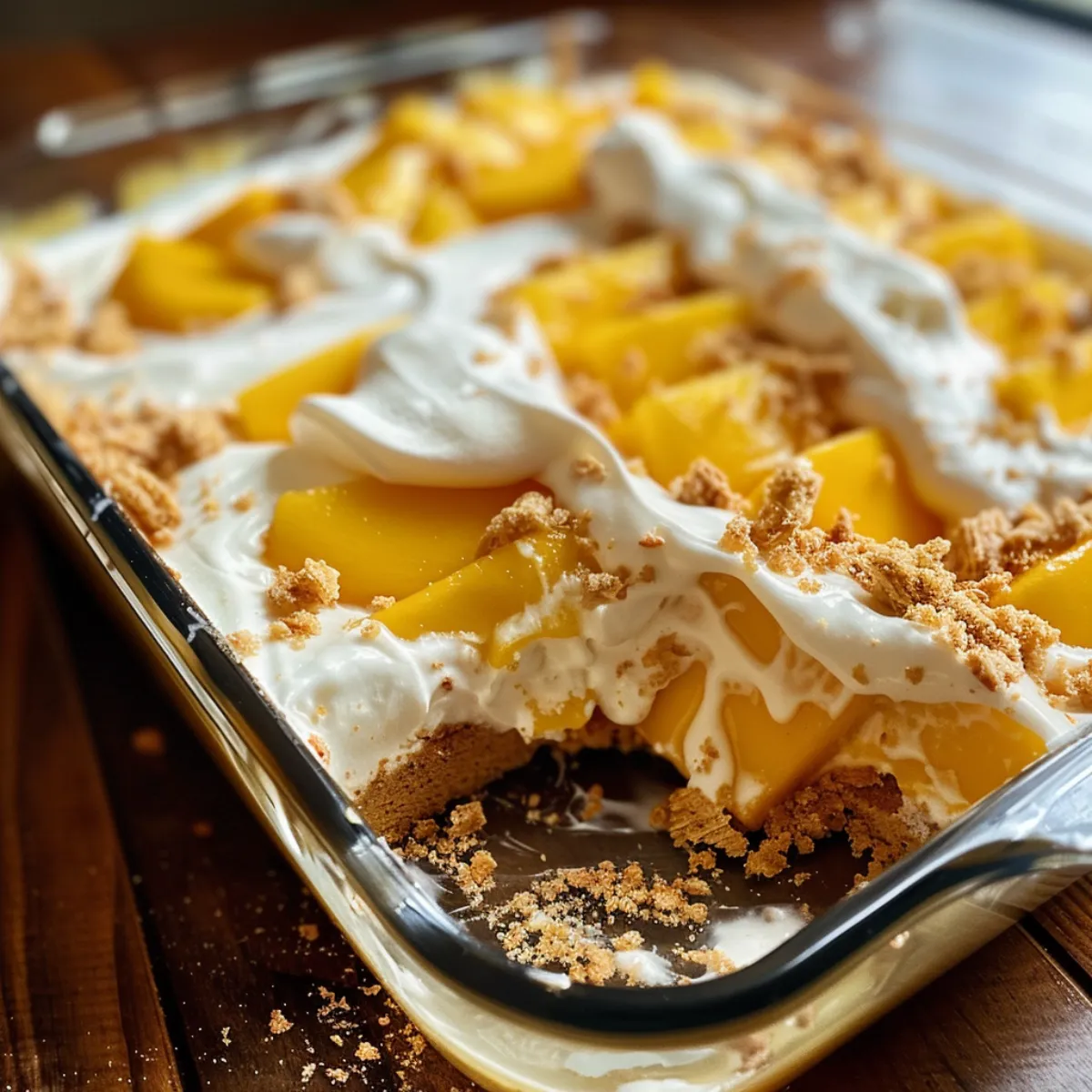
Here are some of my go-to pairings:
| Drink | Why It Works |
|---|---|
| Iced Jasmine or Green Tea | Cuts through the richness with a floral finish |
| Cold Brew Coffee | Bitter contrast enhances the mango’s sweetness |
| Sparkling Water with Lime | Cleanses the palate and adds a refreshing fizz |
| Mango Shake | Double mango action? Yes, please! Just use less sugar |
| Coconut Water | Light and hydrating with a tropical touch |
For celebrations, I like to serve mango float with iced Filipino calamansi juice. The tangy citrus flavor adds a perfect zing.
Garnishing and Plating Ideas for Wow Factor
Let’s be honest—a beautifully served mango float can make jaws drop. I’ve had guests hesitate to dig in just because it looked too pretty to touch (don’t worry—they eventually did).
Here are some of my favorite plating and garnishing ideas:
- Top with mango rosettes: Thin mango slices rolled into flowers. Fancy, but not hard!
- Sprinkle toasted coconut flakes for crunch and aroma.
- Drizzle caramel or mango purée across the top for extra color and richness.
- Use a clear trifle bowl for a 360-degree view of your layers.
- Serve slices with a mint leaf or edible flowers to dress it up.
Pro Tip: Use a hot, sharp knife for perfect slices. Dip in warm water, wipe, and slice again for clean edges.
FAQs About Mango Float
Why is Mango Float so good?
Mango float hits that sweet spot between indulgence and comfort. The richness of the cream, the buttery softness of graham crackers, and the sweet-tart burst of mangoes combine into a dessert that’s both light and satisfying. It’s chilled, fruity, and nostalgic—all at once. And since it’s so easy to make, it’s also one of those recipes that brings people together in the kitchen.
Are Mango Float and mango graham the same?
Mostly, yes! “Mango graham” is a common nickname for mango float in the Philippines. Both are made with the same basic ingredients: graham crackers, cream, and mangoes. The differences lie in presentation or regional names, but they’re essentially the same beloved dessert.
What are some common mistakes when making a Mango Float?
The most common mistakes are using underripe mangoes, overloading with cream, and not allowing enough chill time. These can make your float either too tart, too soggy, or too runny. Always use ripe, sweet mangoes, spread your cream thinly and evenly, and let it chill at least 6–8 hours (preferably overnight) before serving.
Can I use canned mango for Mango Float?
Absolutely! Canned mango works especially well when fresh mangoes aren’t in season. Just be sure to drain off the syrup and gently pat the mango slices dry to avoid making your layers soggy. Adjust the sweetness of your cream accordingly since canned mango is often packed in syrup.
Conclusion
Mango float has taught me that some of the best recipes don’t need baking or fancy equipment—just heart, patience, and great mangoes. Whether you’re making it for a potluck, prepping it for the kids, or creating a tropical twist for your dessert table, this Filipino classic never fails.
And the beauty of it? You can personalize every layer. Try new flavors. Mix and match textures. But at its core, mango float will always be that creamy, fruity, feel-good treat that brings people together.
For more mouthwatering ideas and tropical desserts, follow me on Facebook and Pinterest
Print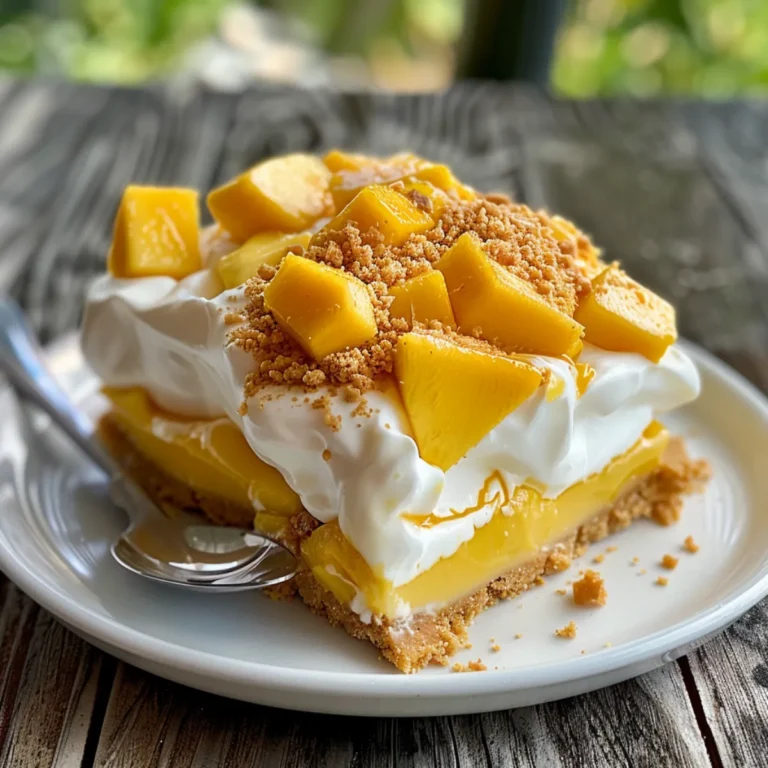
The Ultimate Guide to Mango Float: Creamy Layers of Filipino Delight
Mango float is a no-bake Filipino dessert made of sweet mangoes, creamy layers, and softened graham crackers—perfectly chilled and ready to steal the show at any gathering.
- Total Time: 20 minutes + chilling time
- Yield: 6 to 8 servings
Ingredients
- 3 ripe mangoes (or 2 cups canned mangoes, drained and dried)
- 2 cups all-purpose cream (chilled)
- ¾ cup condensed milk (adjust to taste)
- 1 pack of whole graham crackers
- Optional: crushed graham for topping
Instructions
- Prepare the mangoes: Slice into thin strips or cubes.
- Whip the cream: Beat chilled cream until slightly thick, then fold in condensed milk. Adjust sweetness to taste.
- Layer it up: Spread a thin layer of cream at the bottom of your dish. Add a layer of graham crackers, then more cream, and mango slices.
- Repeat: Continue layering until ingredients are used up. Finish with cream, mango, and optional crushed graham on top.
- Chill: Cover and refrigerate for at least 6 hours or overnight.
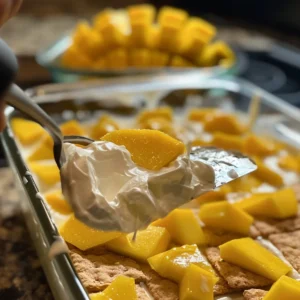
Notes
Chill cream before whipping to get a fluffier texture. Use ripe mangoes for the best flavor and avoid over-soaking the base with cream. For a firmer dessert, freeze for an hour then finish chilling in the fridge.
- Prep Time: 20 minutes
- Cook Time: 0 minutes
- Category: Dessert
- Method: No Bake
- Cuisine: Filipino
Nutrition
- Serving Size: 1 slice
- Calories: 310
- Sugar: 22g
- Sodium: 140mg
- Fat: 18g
- Saturated Fat: 10g
- Unsaturated Fat: 7g
- Trans Fat: 0g
- Carbohydrates: 32g
- Fiber: 1g
- Protein: 4g
- Cholesterol: 45mg
